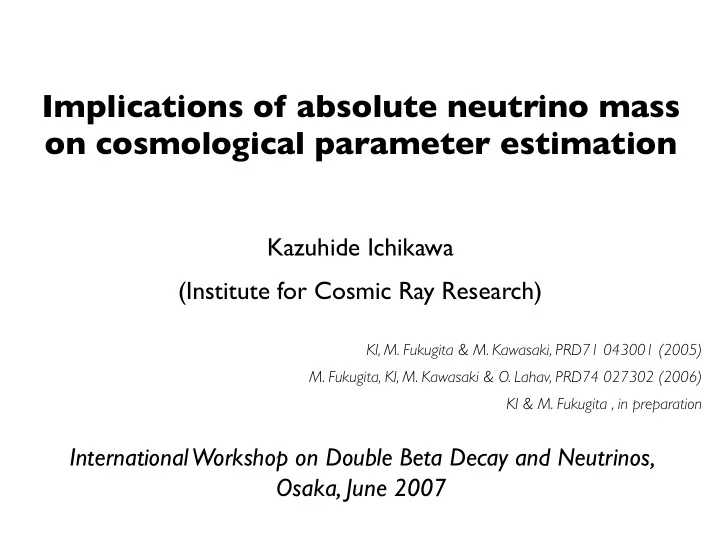

Implications of absolute neutrino mass on cosmological parameter estimation Kazuhide Ichikawa (Institute for Cosmic Ray Research) KI, M. Fukugita & M. Kawasaki, PRD71 043001 (2005) M. Fukugita, KI, M. Kawasaki & O. Lahav, PRD74 027302 (2006) KI & M. Fukugita , in preparation International Workshop on Double Beta Decay and Neutrinos, Osaka, June 2007
There are many works to derive constraint on neutrino masses from cosmological data. m ν (eV) m ν (eV) Ichikawa (2005) 1.0 1.0 Croft (1999) Hannestad (2005) Fukugita (2000) Wang (2002) MacTavish (2006) Elgaroy (2002) Sanchez (2006) Hannestad (2002) Goobar (2006) Lewis (2002) Conservative Conservative Spergel (2003) Spergel (2006) Moderate Moderate Aggresive Hannestad (2003) Aggresive Seljak (2006) Allen (2003) Fukugita (2006) Tegmark (2004) Barger (2004) Feng (2006) CMB only CMB only Crotty (2004) Galaxy power Galaxy power Cirelli (2006) (shape) (shape) Seljak (2005) Galaxy bias and/ Galaxy bias and/ or Ly alpha or Ly alpha Seljak (2005)
χ 2 analysis KI, Fukugita & Kawasaki, PRD71 043001 (2005) (We marginalized over 6 other LCDM cosmological parameters) Fukugita, KI, Kawasaki & Lahav, PRD74 027302 (2006) 14 WMAP3 (full data) 12 WMAP3 (w/o polarization) WMAP1 10 WMAP3 limit (95%CL) : 8 m ν < 0 . 7 eV 6 ~95% CL limit 4 2 0 0 0.2 0.4 0.6 0.8 1 1.2
There are many works on cosmological constraint on neutrino masses. m ν (eV) m ν (eV) Ichikawa (2005) 1.0 1.0 Croft (1999) Hannestad (2005) Fukugita (2000) Wang (2002) MacTavish (2006) Elgaroy (2002) Sanchez (2006) Hannestad (2002) Goobar (2006) Lewis (2002) What if some experiment Conservative Conservative Spergel (2003) Spergel (2006) Moderate detected neutrino mass ? Moderate Aggresive Hannestad (2003) Aggresive Seljak (2006) Allen (2003) Fukugita (2006) Tegmark (2004) Barger (2004) Feng (2006) CMB only CMB only Crotty (2004) Galaxy power Galaxy power Cirelli (2006) (shape) (shape) Seljak (2005) Galaxy bias and/ Galaxy bias and/ or Ly alpha or Ly alpha Seljak (2005)
We need cosmological parameter estimation fixing neutrino mass to some finite value. Assuming massless neutrinos. http://lambda.gsfc.nasa.gov/
We need cosmological parameter estimation fixing neutrino mass to some finite value. The Hubble constant decreases significantly by the finite neutrino mass. m ν ∼ 0 . 5 eV H 0 ∼ 60 ( ) H 0 = 73 . 2 ± 3 . 1 for massless case. http://lambda.gsfc.nasa.gov/
We assume flat Lambda CDM model (6 parameters) + neutrino mass baryon density CDM density Hubble constant epoch of reionization amplitude of fluctuation a slope for the scalar perturbation Hubble constant (expansion rate at present): H 0 H 0 = 100 h km / s / Mpc
neutrino mass (for one generation): m ν We assume three generations and the masses are degenerate. neutrino mass density (relative to the critical density) ω ν = 3 m ν 94 eV 1 eV corresponds to ω ν ∼ 0 . 03 (cf. ) ω CDM ∼ 0 . 105
Proton ~1 degree 4 He nucleus Photon Early galaxies Proton Helium Photon CMB radiation CMB radiation Neutron 4 nucleus Neutron He atom Electron Helium Electron Modern Hydrogen atom H atom First stars Early Modern atom First stars galaxies galaxies galaxies ~300 Mpc R e c o m ~14000 Mpc b i n a t i o n R e i o n i z T ∼ 0 . 6 eV a t i o n Longer distance ∼ cH − 1 H 0 ↓ 0 T o d a y Shorter distance ( becomes ν m ν ↑ nonrelativistic)
CMB angular spectrum H 0 ↓ m ν ↑ Large contrast at ~1 degree
) 6 Hubble constant from WMAP3 0 ) 0 1 74 ± 3 ± 6 2 0 ( 0 assuming massive neutrinos i 2 r c ( 0.85 a n M a m 72 ± 8 d e e 0.8 r F This is not the end of the 0.75 story ! 0.7 h 0.65 ) 6 0 0 2 ( 0.6 e g a d n a 0.55 S 62 . 3 ± 1 . 3 ± 5 . 0 0.5 0 0.2 0.4 0.6 0.8 1 Direct measurements of m ν (eV) [1 sigma Error bars] Hubble constant
Assume h is measured with a total uncertainty of 5% 0.85 A determination of H 0 to 5% (see Table 7) is a con- A determination of H 0 to 5% (see servative goal for the near term. It will require the re- servative goal for the near term. It 0.8 estimation of a maser distance to NGC Macri et al. ApJ 652, 1133, 2006 0.75 0.7 h 0.65 0.6 0.55 0.5 0 0.2 0.4 0.6 0.8 1 m ν (eV)
Conclusion If neutrino mass is detected to be > 0.3 eV, m ν ~ it is consistent with people claiming small Hubble constant. If not detected, upper bound of < 0.3 eV is very ~ useful because uncertainty of is one of the m ν largest systematic errors for estimating cosmological parameters from CMB (most notably for Hubble constant). These correlation between and holds if H 0 m ν we combine CMB data with Supernova and galaxy clustering data. It is also expected to hold in the Planck era.
Recommend
More recommend